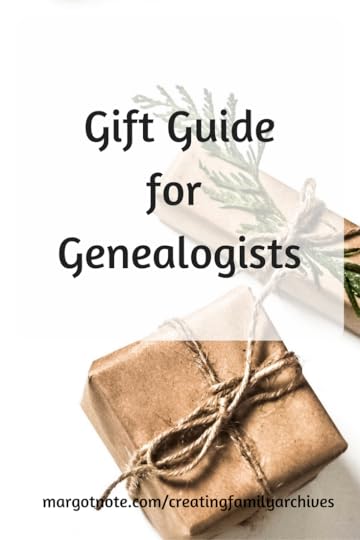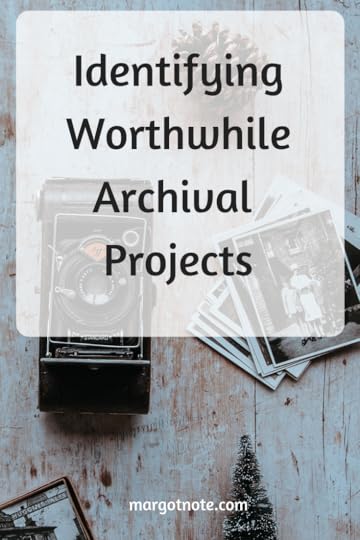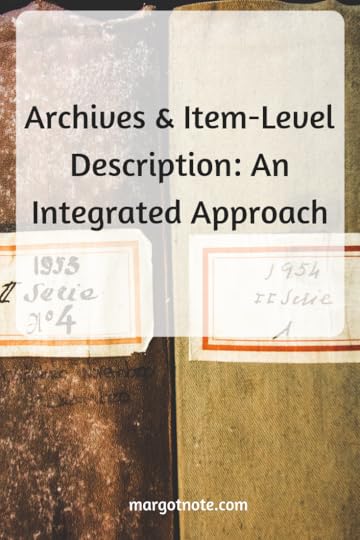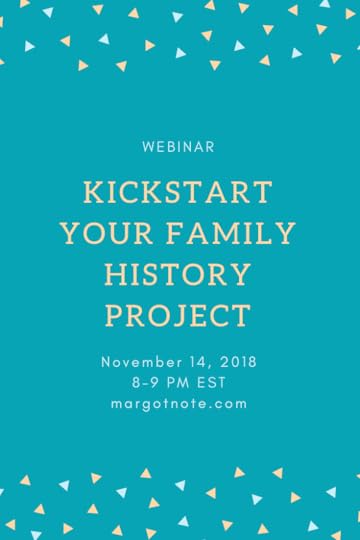Margot Note's Blog, page 37
December 3, 2018
In the Spirit: Five Tips for Preserving Family Heirlooms
I have to admit it—I'm a Grinch.
I've always been this way. I think of the holidays as a time to get through, though I appreciate a celebration of warmth, light, and love in the middle of the winter.
The holiday season can be tough for some of us. It's a time of reflection for all the experiences of the past year, good and bad. The season makes us think of family memories, which can be a source of happiness and sadness.
When I organize archives for clients, I'm struck by how little of today's messages are physical. For example, in a folder of my late father's correspondence to me, I only have two short printed-out emails. Nothing handwritten, nothing not born-digital. I treasure those special emails, but how I wish that they were written in his script!
In the spirit of keeping it real, I'm sending readers a handy cheat sheet, Five Tips for Preserving Family Heirlooms, to shine a little light during a time that can be emotional for us all. "Real" is the key word, because as much as our lives are digital, the tangible world—the real—excites us and connects us as humans. The cheat sheet is limited to the first 50 people that reply.
If you are interested in receiving the cheat sheet, please fill out the form below. (This information will be used for no other purpose and will not be shared, sold, or any other action that would put me on Santa's naughty list).
If you like archives, memory, and legacy as much as I do, you might consider signing up for my email list. Every few weeks I send out a newsletter with new articles and exclusive content for readers. It’s basically my way of keeping in touch with you and letting you know what’s going on. Your information is protected and I never spam.
To learn the preservation secrets used by libraries, archives, and museums to protect their priceless materials (that you can also use for your family heritage items), read my book:
Creating Family Archives: How to Preserve Your Papers and Photographs
By Margot Note
Ready to get started creating your family archives? Here are some of my favorite products:
Follow me on Pinterest | Instagram | Twitter | LinkedIn | Facebook



November 26, 2018
Gift Guide for Family Archivists
A gift that celebrates memories is so much more than a present. An occasion for gift giving--the holidays, a birthday, an anniversary--is all about the experience. Everything's better when you enjoy it together.
Here's a list of distinctive presents for everyone on your nice list. They are suitable for people of any age. They are affordable as well; most gifts are $10-$20, with many under $10. When you purchase items through these links, I receive a small percentage of the cost through the Amazon Associates program. You can buy curated, high-quality items at the same that you support my work. The ties that bind these gifts together is that they cherish the past or create the future.
For Family Archivists
I would be remiss for not mentioning my book, Creating Family Archives: How to Preserve Your Papers and Photographs, as a thoughtful gift. It's an easy, quick, and affordable guide to protecting your treasures. I've also selected a collection of my favorite Gaylord Archival items for beginners, including family history kits, enclosures, and folders, that I advise my clients to use and that I use myself. I've also created the ultimate archival supply shopping list that goes into more detail about what beginning archivists need to get started.
I offer services for individuals and families, with three levels of expertise. A family archives package is a unique gift for a friend or relative who values their heritage, but doesn't know what to do to protect it. It would be my pleasure to show you how! Learn more HERE.
I've created a couple of on-demand tutorials for you to access at any time. Access Organize What's Meaningful to You, Kickstart Your Family Archives Project, or both for additional savings. You will receive videos jam-packed with content, as well as a growing collection of family history tools, articles, oral history kits, podcasts, and other resources; unlimited access to the tutorials; automatic upgrades to any new content, and other goodies. Learn more HERE.
For Memory Makers
Lea Redmond's Letters to... series provides prompts for letters to loved ones. Letters to My Friend: Write Now. Read Later. Treasure Forever. offers 12 letters to celebrate a cherished friendship.
A gift of a recipe box with 100 recipe cards (and a potential to hold twice as much) allows family members to record their favorite recipes. I like this box because of its clean, modern design; a groove on the top of the box allows you to view your recipe easily.
The Memories line of Homesick candles are the best. The Books scent smells like an older leatherbound book mixed with a woody desk character of cedar and sandalwood. Hints of balsamic and vanilla finish the complex scent. Doesn't that sound wonderful? This hand-poured soy wax candle burns for 60 to 80 hours.
Drop a note to friends and family with letterpress printed cards. My favorite is a set individually printed on a 1930's letterpress with a vintage typewriter motif with "just a note" in black on the front. They're blank inside. The cards measure 3.5" x 5" and come neatly packaged with a variety color of envelopes. If these aren't your style, I suggest seeking another set of letterpress stationery; they have a luxe, handmade touch that stands out among slick and impersonal commercial cards.
An archival-quality photo album kit includes everything you need to safely present precious family photos in an elegant black album. The kit includes a buckram cover, mounting pages, protectors, photo corners, and envelopes that are acid-free to safely store photos, negatives, newspaper clippings, and other memorabilia. I've written a post about purchasing and using the album to recreate a damaged magnetic album.
For Kids
In Home, artist Carson Ellis makes her solo picture-book debut with a whimsical tribute to the many possibilities of home. I spotted this book at The Strand and was immediately drawn to it. The book has a beautiful tone that invites many return visits. It also introduces the important concept of how the places we live shape our lives.
These forest friends bookplates are so cute. The 80 bookplates were illustrated by Quill & Fox. They feature colorful owls, worms, squirrels, foxes, beavers, ladybugs, rabbits, and hedgehogs. It makes a fun gift for the little bookworm in your life.
Let's Make Some Great Art is such an inspiring book; it’s full of activities and lessons on artists, and is a great tool to get kids’ creative juices flowing.
Nothing beats the ease of taking photos on your cellphone, but there’s something retro about the Instagram-like wallet-sized photos produced from a Fuji Instax. All kids should experience the tangible aspects of photography, especially instant photography. Archivists and conservators are unsure about how long digital images will last. Physical images (when preserved properly) will survive hundreds of years.
The classic My Book About Me, By ME, Myself encourages children to write and draw their own biographies. It's an ideal gift for elementary school children and one that will become a cherished keepsake. (I loved filling in my copy as a child!)
For Readers
Paper Love: Searching for the Girl My Grandfather Left Behind by Sarah Wildman documents her journey to find the lost love her grandfather left behind when he fled pre-World War II Europe. The book begins when she finds a cache of letters in his old files, then ends in an exploration into family identity, myth, and memory.
In Sidonia's Thread: The Secrets of a Mother and Daughter Sewing a New Life in America, Hanna Perlstein Marcus writes about her journey with her mother, Sidonia, who came to Massachusetts from a displaced persons camp after World War II. Sidonia supports herself as a talented seamstress, yet hides many secrets. As an adult, Hanna searches through her mother's old letters and photographs to find clues about her heritage.
The House in Prague: How a Stolen House Helped an Immigrant Girl Find Her Way Home follows Anna Nessy Perlberg's life from witnessing the Nazis invade Prague in 1939 to after the Velvet Revolution in 1989. The book is illustrated with pictures from the author’s family archives.
97 Orchard: An Edible History of Five Immigrant Families in One New York Tenement by Jane Ziegelman investigates the culinary habits of five ethnic families living at the turn of the twentieth century in one tenement on the Lower East Side of Manhattan. It includes 40 recipes.
In search of a place to call home, thousands of Hmong families made the journey from the war-torn jungles of Laos to the overcrowded refugee camps of Thailand and onward to America. Lacking a written language of their own, the Hmong experience has been primarily recorded by others. Driven to tell her family’s story after her grandmother’s death, The Latehomecomer is Kao Kalia Yang’s tribute to the remarkable woman whose spirit held them all together.
For Writers
The Blackwing pencil was introduced in the 1930's by Eberhard Faber and was the pencil of choice for Oscar, Grammy, and Pulitzer Prize winners throughout the 20th century. Pencil aficionados from John Steinbeck to Thomas Wolfe to E.B. White have sung the praises of the Palomino Blackwing pencil. After it was discontinued in the 1990's, fans began paying as much as $40 per pencil to seize unused stock. These are perfect for writing in your journal, scribbling down notes as you interview family members, or crafting letters to loved ones.
The Fisher space pen is one of the most popular pens of the twentieth century. The original Fisher Space Pen was used on the Apollo 7 space mission in 1968 after two years of testing by NASA and has been used on all manned space flights since then. The design and construction of the pen hasn't changed; it's exactly the same as the one taken to the moon. The pen writes at any angle, even in Zero Gravity, and in extreme temperatures.
Writers can jot ideas down quickly with a set of three Moleskine Cahiers. These flexible, singer-bound journals have indigo blue covers and visible stitching on the spine. The ruled pages are acid-free, so they are easy to preserve.
For a more substantial notebook, choose Leuchtturm. These notebooks helps you get organized with numbered pages, a blank table of contents, and a set of stickers for the cover and spine that allow for clear labeling and archiving. I've chosen a notebook with plain paper; you can also choose lined or dots (for bullet journals).
The Miracle Time Cube is perfect for overcoming procrastination. You can set it to 5, 15, 30 and 60 minutes and research, write, or edit until it beeps.
What gifts are you looking forward to giving and receiving?
To learn the preservation secrets used by libraries, archives, and museums to protect their priceless materials (that you can also use for your family heritage items), read my book:
Creating Family Archives: How to Preserve Your Papers and Photographs
By Margot Note
If you like archives, memory, and legacy as much as I do, you might consider signing up for my email list. Every few weeks I send out a newsletter with new articles and exclusive content for readers. It’s basically my way of keeping in touch with you and letting you know what’s going on. Your information is protected and I never spam.
Follow me on Pinterest | Instagram | Twitter | LinkedIn | Facebook



November 19, 2018
Identifying Worthwhile Archival Projects
The most vital aspect of managing a successful archival project is identifying the right problem to be solved. In the cultural heritage sector, too many excellent exciting projects exist, but limited resources hamper seeing them to fruition. Archivists should prioritize projects that add value to the organization.
Projects should reduce costs, expand services, or increase efficiency—and be linked to these objectives from start to finish. Archivists must change their mindset from simply completing a project to strategically implementing the project with business objectives in mind.
Organizational AlignmentThe proposed archival project should align with the organization’s strategic goals and priorities. If it fails to do so, the effort risks wasting time and resources that should have been applied to more important priorities. Activities that identify, analyze, and improve existing processes are often excellent candidates for projects. As you plan projects, think of ways in which you can deliver services faster and more easiliy, with less work. Process measures examine the efficiency of procedures (throughout the day) that use resources, primarily staff time. These are common in information centers like libraries, archives, and museums where value-added services and experiences are appreciated.
Consider project suitability as well. The right projects satisfy three simple but necessary criteria. They first address an established need. They then are shown to be worthwhile financial investments. Finally, they rank among the best opportunities. Many projects are good ideas, but archival organizations should only implement the best, appropriate, and impactful projects.
Developing a Business CaseExplore potential projects by creating a business case for them, analyzing the many opportunities they could provide the organization. The business case is a justification for a proposed project based on its expected benefits. It describes success regarding measurable positive results. It includes the issues to be addressed, the goals for undertaking such a project, and the project’s objectives.
The project sponsor, someone in a leadership position that champions your work, is often the best person to develop the business case because he or she will handle delivering a successful outcome. Archivists who will also be project managers may help to develop business cases as well because it allows them to become familiar with the project they will run. It is also necessary to be involved in the business case since it will secure needed project resources. Senior executives should approve the business case once it is completed.
Assessment TechniquesA SWOT analysis—a review of the internal and external environments to determine its strengths, weaknesses, opportunities, and threats—is helpful for determining the business case. Strengths and weaknesses are environmental factors internal to the organization; opportunities and threats address external issues. This analysis is a classic tool used in strategic planning. At the project level, it provides a rationale for the project, or it may uncover information that matches the organization’s resources and capabilities to the environment in which it operates.
Another similar assessment technique is the PEST (political, economic, social, and technological) analysis or the extended version, PESTEL, which adds environmental and legislative aspects. This procedure is helpful when conducting a strategic study of factors that an organization needs to take into consideration when selecting projects.
Feasibility StudiesIf the project is large or innovative, a feasibility study may be required before beginning the detailed work of planning and implementation. A feasibility study takes into account the variables of the project, including budget, resources, and time constraints, and determines the likelihood of completion given the available resources. It aids you in determining the validity of a proposed project or a section of the project. You may also be tasked with writing a feasibility study to examine the economic aspects of the project. If a project can be done in many ways, a feasibility study can clarify the best option to achieve the objectives. It can also help determine if the project is unachievable.
Feasibility studies are written with upper management in mind. As you draft it, explore how the proposed project will benefit the organization. The study usually includes an executive summary, the purpose, a description of the options assessed, assumptions, the potential audience, financial obligations, and recommended actions. Each section should be brief and provide supporting evidence.
Political PowerArchivists should recognize the authority, political standing, and aspirations of senior executives during the project selection phase. Influential stakeholders are likely to get their projects approved based on who they are.
During my experience as a “lone arranger” at a nonprofit, as well as my current work as a consultant, I have found that some projects move forward quickly, based on the power wielded by the stakeholders. This can be both a blessing and a curse. The authority granted by a high-level person in an organization who backs a project can allow funding and resources to flow more quickly and can break through internal roadblocks. On the other hand, some ill-conceived projects are set in motion, even though they probably should not.
While business cases and feasibility studies enlighten some stakeholders, if an executive in the organization champions a project and has enough influence to get it approved, there may be little to do except to implement it. In this case, as project manager, you can apply processes to make the project as successful as possible given the circumstances.
I started to explore project management at a time that I was employed as a subject matter expert on two projects that seemed doomed from the start, yet had to be completed because of executive pressure. In both circumstances, I voiced my concerns when required, performed my tasks for the project as well as I could, and let the project lead and sponsor take care of the rest of the problems.
The ProposalA proposal is the first step to launching a project. It includes the vision of the project that the stakeholders authorized for completion. The proposal is a necessary fiction because it is an idealized version of what the project could be. It contains both the intellectual vision for the work and a plan for its completion. It is impossible to know for sure what future steps and technologies will be appropriate to complete any deliverables. In transforming the proposal into a plan, archivists need to be flexible. The pace of change in technology means that once the work begins, there may be better means to do the tasks. Yet, the proposal allows you to envision how you will complete your noble archival project.
The blog was originally published on Lucidea's blog.
If you like archives, memory, and legacy as much as I do, you might consider signing up for my email list. Every few weeks I send out a newsletter with new articles and exclusive content for readers. It’s basically my way of keeping in touch with you and letting you know what’s going on. Your information is protected and I never spam.
Follow me on Pinterest | Instagram | Twitter | LinkedIn | Facebook

November 12, 2018
Archives Collection-Level Description: Pros & Cons
Although some archivists debate the necessity for item-level access, it is often more challenging to describe images in the aggregate. Collection-level description can be useful for images of the same subject, but problematic for collections with a variety of subjects, as it neither improves retrieval nor limits the handling of the originals. Group arrangement and description are necessary for large collections or when resources are limited.
The Sum is Greater Than its PartsCollections can be accessed as a single unit or organized intellectually under a sole classification while being physically stored or electronically displayed in separate groupings. Archival collections tend to be characterized by a coherence that binds the contents together and, as a result, a totality enhances the research value of each item beyond what it would have in isolation.
Archivists can evaluate the appropriate description treatment for a given group of materials: whether the items should be cataloged at the item or collection level. They can create catalog records and finding aids, frequently using a combination of description levels to facilitate access. This blended approach allows control over the holdings at the collection level, as well as specific control over individual assets at the item level. This method is especially important for high-demand items, items used in exhibits, or items with high intrinsic or market value. Evaluative methods should be used to determine the level of description required.
Subject DescriptionThe literature about subject indexing of images, especially, emphasizes the need for greater access at the primary subject level of description. Description generally concerns an image’s secondary subject matter. This means that a user must have a certain amount of specialized knowledge to find an image. Anyone searching a collection of images accessible only by secondary subject matter is at the mercy of the indexer’s interpretation. Additionally, one cannot search across a collection for basic attributes.
Given the interdisciplinary nature of research, it is desirable that a collection of images be searchable by anyone and for a variety of purposes. In many institutions, however, retrieving an image requires knowledge of its creator or its title, supplied by either the image creator or the cataloger. Often, only collection-level descriptions are available. This means that image construct queries are simply not possible, and the user must either have specialized knowledge or rely on the memories of the individual collection managers. Describing images by their primary subject matter preserves information that both specialists and non-specialists can use to gain access to the collection.
Subject IndexingAccess to analog image collections is usually provided through finding aids, which only include subject indexing for large collections, if at all. In my experience, the most frequent approach to image retrieval is by subject. With historical photograph collections, subject descriptors were by far the most commonly used term, while words indicating place, time, and proper names were next in importance. Regardless of the resources involved, without subject access, many requests for images could not be answered. The overwhelming majority of the users who seek images by their subject indicates the importance of these terms for retrieval. Any amount of subject indexing, even of only the main subjects of photographs, can only improve access.
Whatever the depth of subject description chosen for images, the indexing of images should accomplish two things. First, the indexing of images should provide access to images based on the attributes of those images. Second, the indexing of images should provide access to useful groupings of images, not simply access to individual images.
The Depth of DescriptionWhen devising indexing schemes or indexing images, it is necessary to decide which attributes need to be indexed, which can be simply noted in conjunction with images, and which may be left for the searcher for the images to perceive. That is, it is necessary to determine which attributes are needed to provide useful groupings of images, which attributes provide information that is useful once the images are found, and which attributes may be left to the researcher to identify. However, practices vary considerably, depending on the repository, the resources available, the size and requirements of the collection, and user needs.
Ultimately, the needs of each institution must be addressed in determining the depth of description required for their holdings. As with all collections, seasoned archivists will evaluate the best level of description needed to make their collections accessible to users.
The blog was originally published on Lucidea's blog.
If you like archives, memory, and legacy as much as I do, you might consider signing up for my email list. Every few weeks I send out a newsletter with new articles and exclusive content for readers. It’s basically my way of keeping in touch with you and letting you know what’s going on. Your information is protected and I never spam.
Follow me on Pinterest | Instagram | Twitter | LinkedIn | Facebook

November 5, 2018
Archives & Item-Level Description: An Integrated Approach
Traditionally, archivists have dismissed arrangement at the item level as having little utility and being impractical for modern collections. However, archival surveys conducted over the years have found that a significant proportion of archivists have adhered to item-level description—even though it is contrary to the traditional archival practice of collection-level description. The same discrepancy between literature and practice appears to be true for visual collections.
Item-level description is more common with visual materials than with textual materials. Conventional processing techniques for pictorial collections presuppose that photographs must be treated individually. Archivists must evaluate their visual collections to determine if item-level description is warranted. Sometimes, it is unavoidable.
Possible Descriptors for Archival MaterialsThe number of descriptors for archival materials (at the item or collection level) abound. They may include:
Titles of the collections or items
Names of the persons or organizations who created, accumulated, or maintained the items, including variant names and pseudonyms
Subjects or themes
Functions, activities, or roles for which the items were created, used, and assembled
Date(s) of creation
Geographic terms identifying place names or physical features
Relationships with other organizations or persons
Quantity or extent
Formats
Size
Hierarchical Description: Is it Possible?It is difficult to apply traditional hierarchical description to visual materials. Item-level description of photographs, indexed by subject and credited to the photographer, but without adequate contextual information about their origins and provenance (or links to such contextual information), transforms photographic archives into stock photo libraries. Itemizing images in this way reduces photographs to their visible elements and conflates photographic content and photographic meaning. Images of enduring value are more than just what they picture; they provide a window to the past.
The diverse array of information that can appear within a single photographic image suggests that the most effective access is provided through description at the item level, in spite of the overwhelming strain on financial and human resources that such an approach entails. Although it is time-consuming, item-level description makes images searchable, and, with digital images, viewable without having to retrieve the originals. However, resources are seldom adequate to catalog all collections to the item level, and item-level handling should exist within a framework provided by collection-level description. Repositories with limited budgets may digitize one or two representative images while noting that there are additional unscanned images.
The Importance of LinkingIdeally, an adequate amount of information should be provided for each image. Also, the image should be searchable by subject, through subject headings or keywords. Linked item-level records can provide the most information and are the most searchable, both within and among collections. However, due to the labor involved, linking may be impractical for sustained digitizing initiatives of collections of any significant size.
An Integrated ApproachAs archivists, we should have an integrated approach to digital initiatives, from selection to description, from access to preservation, with an emphasis on the intersection of cultural objectives and practical digital applications.
While photographs are used increasingly to support a broad range of research topics, their management remains far from standardized. Like images themselves, image description begins with an understanding of context. There is no right way to manage images, only best practices that inform decisions based on the reasons for digitizing, the nature of the images, the institutional mission, available resources, the technical infrastructure, and user requirements.
The blog was originally published on Lucidea's blog.
If you like archives, memory, and legacy as much as I do, you might consider signing up for my email list. Every few weeks I send out a newsletter with new articles and exclusive content for readers. It’s basically my way of keeping in touch with you and letting you know what’s going on. Your information is protected and I never spam.
Follow me on Pinterest | Instagram | Twitter | LinkedIn | Facebook

October 29, 2018
Records Management Consulting: Meet Your Legal, Regulatory, and Business Objectives
My records management consulting services align information lifecycle controls with your business priorities, resulting in regulatory compliance, risk mitigation, and measurable business efficiencies.
Benefits of Records ManagementA record is evidence of a business activity or transaction, regardless of its physical media. For example, it can be a paper or electronic record. A records retention program includes the systematic storage, tracking, and destruction of records created while doing business. It identifies the records that need to be kept and outlines guidelines for how long different record types should be stored and how they should be destroyed.
Good records management saves time, costs, and space and mitigates risk. Records management provides the right information at the right time to the right people at the lowest possible cost. A retention program will also make doing your job easier.
The Expertise of a ProfessionalMany organizations (large and small) don’t have a records manager but can benefit greatly from a consultant such as myself who can deliver measurable results to reduce risk, save money, and increase efficiency.
My steadfast commitment is to a meticulous standard of collaboration with my clients. I customize my solutions for your unique culture and capabilities. I work independently so I can offer you the best, unbiased advice and excellent customer service. Unlike consulting firms with big overheads and even bigger invoices, I am a lean entrepreneur who offers incredible value by working directly with me—the expert.
Practical, Cost-Effective SolutionsAs a certified records manager, I help my clients to:
Identify and solve problems
Mitigate business and litigation risk
Promote regulatory compliance
Integrate processes and technology
Improve efficiency
Optimize existing tools and resources
Employ tested concepts and tools
Three-Step Trusted ProcessStep 1: Clarify
I help you see the big picture by:
Assessing the maturity of your program
Benchmarking your records management practices against the industry
Devising a strategic direction
Inspiring change throughout your organization
Step 2: Conceptualize
I collaborate with you by:
Developing practical short and long-term plans
Leverage your technology and plan for automated solutions
Preparing communications and training to propel change
Formulating sustainable programs
Step 3: Create
I work with you to embed change by:
Implement information lifecycle controls
Effecting change across your operations
Instilling continuous improvement
Demonstrating measurable results
Leverage Knowledge and ResourcesInterested in learning more? Contact me to begin a conversation about your records management needs.
Contact
Like this post? Never miss an update when you sign up for my newsletter:
Follow me on Pinterest | Instagram | Twitter | LinkedIn | Facebook
October 22, 2018
Put Your Weight On It: What Rudy Ray Moore Teaches Us About Work
Rudy Ray Moore has been called “the Godfather of Rap,” and is best known as Dolemite, the lead character of the 1975 film Dolemite, and its sequels, The Human Tornado and The Return of Dolemite. He was one of the greatest blaxploitation stars, highly influencing comedians such as Red Foxx and Richard Pryor and rappers like Snoop Dogg.
In the 1979 action film Disco Godfather (also known as Avenging Disco Godfather and Avenging Godfather), Moore plays a retired cop who owns a disco and tries to stop a local PCP dealer after his nephew gets involved with the drug. The movie can best be described as a cross between Soul Train and a hallucinatory anti-drug public service announcement.
The Disco Godfather’s trademark phrase to the club patrons is to “Put your weight on it!” He screams the phrase 24 times throughout the film, apropos to nothing. Moore is even credited with the phrase in the end credits.
I am not entirely sure what he means, but the phrase resonates with me. The Urban Dictionary defines it thusly:
verb phrase: to dominate; to take control of the situation; to make yours.
It’s a call to action: be present and be happy.
Disco Godfather is most content at work—DJing for an audience—but it doesn’t seem like work to him. Sure, he’s a bad dancer and his jumpsuit may be too snug, but he’s thrilled to jump into the DJ booth and recite rhyming couplets to the audience. You could watch this film with a jaundiced eye, noting the flubbed lines and the bad edits but what value would you get out of it?
Let’s apply this to our careers. Sometimes the work that we’re involved in, for whatever reason, isn’t that great, but we still have to show up and do it. Sometimes we love what we’re doing, but no one else values it. Sometimes the work is something that just needs to get done.
I’ve noticed that the people most likely to be cynical at work are those who are not creating anything of value themselves and often aren’t doing much at all. Work would get in the way of finding things to criticize!
The rest of us, though, are building something better. It may not be perfect, but it’s something.
Let them lean back and disparage. We’re putting our weight on it.
October 18, 2018
Webinar: Kickstart Your Family History Project
Everyone collects a lifetime of papers, photographs, and mementos that tell the stories of their lives. This is our "stuff."
When I talk to people about organizing their stuff, I hear repetitively, "I want to get organized, but I feel so overwhelmed!" I know the feeling of finding messes that seem so daunting that I didn't even know where to begin. But organizing your stuff doesn't have to be daunting. We just need a plan of action to make our efforts achievable.
I've created a webinar to explain the easy steps you can take to organize and preserve what's meaningful and important to you. The focus is on family and personal items--like papers, photographs, and audio-visual items--but the methods I discuss can be used for organizing anything. Feel calmer and less stressed knowing that your stuff is in order and you can find everything you need.
Tickets are only $5 until 11/1/18!
What this webinar offers:
Tips and tricks archivists use to preserve materials
Ways to get quicker, easier, affordable results for organizing your stuff
Ways to approach an overwhelming organizational project so that it's manageable
Real-world examples of how to approach organizational projects
Generous Q&A time so that I can answer all your questions
Follow-up materials to help you get started
Exclusive access to a private Facebook group to support your efforts
Learn tips and techniques right from the comfort of your computer, so grab your seat for Wednesday, November 14, 2018 from 8:00 PM – 9:00 PM EST. Won't you join me?
Register for the webinar here.
If you like archives, memory, and legacy as much as I do, you might consider signing up for my email list. Every few weeks I send out a newsletter with new articles and exclusive content for readers. It’s basically my way of keeping in touch with you and letting you know what’s going on. Your information is protected and I never spam.
To learn the preservation secrets used by libraries, archives, and museums to protect their priceless materials (that you can also use for your family heritage items), read my book:
Creating Family Archives: How to Preserve Your Papers and Photographs
By Margot Note
Ready to get started creating your family archives? Here are some of my favorite products:
Follow me on Pinterest | Instagram | Twitter | LinkedIn | Facebook

October 15, 2018
The Current State of Description for Archives
In July 1945, Atlantic Monthly published “As We May Think,” by army scientist Vannevar Bush, an essay that had an immense influence on the history of computing. Bush was concerned about the explosion of information without a means to quickly retrieve data.
The article described a device called a Memex, an intuitive, associative retrieval system designed to supplement memory. He envisioned a desk with screens that would allow users to view documents, add notes, and create associations through a body of work.
The Memex was a conceptual ancestor to electronically linked materials and, ultimately, the Internet. Bush’s ideas were expanded by Theodor Nelson who, in 1961, coined hypertext and hypermedia to describe the environment where text, images, and video could be digitally interconnected.
The popularity of the Internet and the improvement of technology allowed for online access to archival holdings, as well as created an impetus for many institutions to provide more in-depth descriptive information for their holdings. Archival collections are among the least accessible resources available because of their size, organization, physical fragility, and basic cataloging. Many collections consist of large groups of related materials that share one or more significant characteristics, such as source, subject, or medium.
Description for Archives, Libraries, and MuseumsArchival description has sought to combine traditional library and archival practice with the more focused descriptive practices found in the museum and visual resources communities. Libraries catalog published, non-unique items, such as books and serials, which are published with multiple copies and a list of descriptors, such as author, title, publisher, and year, which appear printed on the book and leave little room for subjective opinion. As soon as one library catalogs a book, any library can copy its cataloging and apply it to its holdings. Catalogers in libraries use standards such as MARC (Machine-Readable Cataloging) and AACR2 (Anglo-American Cataloging Rules, Second Edition) with LCSH (Library of Congress Subject Headings) descriptors. AACR2 and MARC are heavily biased toward printed documents, which is not surprising given that they matured before digital assets were commonplace. Libraries have only recently begun to catalog individual items in their collections but have typically not described the collections that contain them.
Subjective Descriptive MethodsMuseums, on the other hand, have acquired expertise in describing their unique holdings, usually describing the collection first and the individual items secondly, grouping items together by artist, media, provenance, or historical period. Description often includes style or genre, history and use of the item, and preservation details. Much of the information registered when cataloging an artwork at one museum cannot be copied and applied to another work held by another institution. The attributes of the items and their most basic descriptors are often speculative or subjective. For example, artist name, year of production, and place of origin do not appear alongside the work at its inception as with a book, but rather require curators to research them and come to their own conclusions. This subjective descriptive method leads to different information on the same object. Practices also vary because of the diverse nature of individual museums and their collections.
Archival DescriptionArchives create detailed descriptions of unique materials or their representations, usually original unpublished material or primary sources, which can be expressed as both item- and collection-level records. In archival practice, description expands upon information gleaned during appraisal and arrangement, which produces preliminary descriptive forms, such as container lists, summarizes the context and content of archival materials at multiple levels, and adds usage restrictions and access points for creators and subjects. Archives catalog their materials using subjective descriptive texts and individual cataloging fields.
Challenges of Image DescriptionArchival collections often do not have a clearly defined or preexisting organizational structure, individual titles, or creator names by which they can be described. In the case of libraries and archives, it was a natural progression to use methods already developed to describe books and documents, to describe other assets. However, these bibliographic methods do not adequately address the unique characteristics of archival collections. No single description method has been developed that can meet the description needs of all archives, libraries, and museums—and their description differences make searching for materials across types of institutions challenging.
An Act of TranslationCataloging archival materials can be idiosyncratic, knowledge-intensive, and time-consuming because the very characteristics that make these assets valuable also make them difficult to describe. Poor-quality records often exist because they are created by people who are not catalogers, are created based on local practice that does not facilitate interoperability, or are based on traditions that do not translate well for managing digital objects. Adding to that difficulty, description and retrieval is an act of translation, complicated by transforming concepts to words, particularly to specialized terms that might appear in an index or thesaurus, and mapping the terms of a mental model or natural-language query to controlled language—which is fundamentally different from the processes of subject cataloging of texts.
Even with the emergence of online catalogs, web-accessible collections, and improved information searching and navigation, access to archival collections has remained limited due to a lack of standardized description and integrated modes of access. We need more tools to automate processes for metadata creation, revision, and harvesting; this would provide benefits regarding consistency, interoperability, and long-term viability of meaningful metadata. The initial expense and difficulty of creating high-quality metadata is compounded by the need for constant revision to correct mistakes and incorporate changes to subject terms, taxonomies, and controlled vocabularies—along with changes to meet continually evolving patron research needs.
With each new project we complete as archivists, we move ever closer to presenting our users with collections they can access much more easily. The effort expended to describe our historical holdings is well worth the effort.
The blog was originally published on Lucidea's blog.
Like this post? Never miss an update when you sign up for my newsletter:
Follow me on Pinterest | Instagram | Twitter | LinkedIn | Facebook
October 8, 2018
Metadata Best Practices
Metadata is structured data about data, information that facilitates the management and use of other information. The function of metadata is to provide your users with a standardized means for access to digitized materials. However, it is not enough to use just any metadata standard.
Resources which are encoded using open standards have a higher chance of remaining accessible after an extended period than resources encoded with proprietary standards. A metadata standard appropriate to the materials in hand and the intended end-users must be selected.
Taking Care in CreationMetadata can identify the name of the work, who created it, who reformatted it, and other descriptive information. It can also provide unique identification and links to organizations, files, or databases that have more extensive descriptive metadata about the archival asset. Metadata is a critical component of digital resource development and use and is needed at all stages in the creation and management of archival resources.
Archivists should take as much care in the creation of the metadata as they do in the creation of the data itself. The time and effort expended in recording quality metadata are likely to save users much grief and to result in digital objects that are sustainable. In my experience, metadata is the most effective tool for managing and finding objects in the complex world of archives.
Choose WiselyChoosing the most appropriate metadata standard is only the first step in building a valuable information resource. Unless the metadata elements or data structure are populated with the appropriate data values, the collections will be ineffectual, and users will not be able to find what they are looking for, even if it’s there. There is no one-stop-shop for the appropriate vocabulary tool for any given project. Instead, builders of information resources should select from the menu of vocabularies most appropriate for describing and providing access points to their particular collections.
Some Rules of ThumbWhen determining which metadata schema to use, take into account the needs and search preferences of your users, and leverage existing institutional indices and finding aids as a basis for your metadata. There is no point in recreating the wheel when you have perfectly usable information readily available.
Base the metadata schema on the existing published schema closest to the institution’s needs; depending on your collections, the right scheme to use may be obvious. Adapt the schema to your needs by adding or omitting elements, but use the same name and definition of each element as in the published schema to avoid confusion. Granularity is important to consider. You can subdivide elements into the smallest sub-elements needed, with the knowledge that elements can always be merged later.
A set of compatible cataloging rules should always accompany the schema. For example, if the schema includes elements drawn from VRA Core—a data standard for the description of artworks and the images that document them—the corresponding rules from Cataloging Cultural Objects (CCO) should be followed.
Set up editorial and quality control procedures to ensure that the cataloging records conform to the rules, and test the schema and the rules thoroughly before it is too late to change them. Discover early in the project if the metadata displays correctly on the institution’s website and if users are satisfied with the records. You will also need to plan where to store the metadata: embedded within the image file, in a separate metadata database, or both.
As always, be prepared for change as time passes, and design systems accordingly. For example, more metadata elements or controlled vocabularies may need to be added as the collection expands. Remember to remain flexible!
Many Ways to AccessUnfortunately, no single system has yet been widely adopted for tracking ‘data about data’ in libraries, archives, and museums. The prudent course for archivists is to understand the current challenges, emerging principles, and best practices before implementing any particular metadata solution. Use your judgment about the collection, and your users, to determine the best way to enable access to your holdings.
The blog was originally published on Lucidea's blog.
Like this post? Never miss an update when you sign up for my newsletter:
Follow me on Pinterest | Instagram | Twitter | LinkedIn | Facebook



